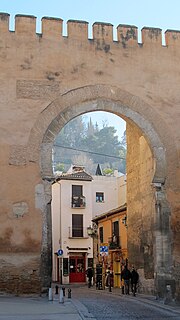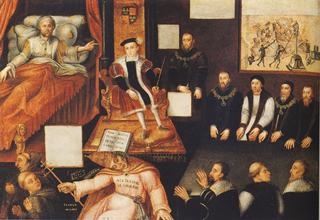 W
WSince the beginning of the serious study of the history of Buddhist art in the 1890s, the earliest phase, lasting until the 1st century CE, has been described as aniconic; the Buddha was only represented through symbols such as an empty throne, Bodhi tree, a riderless horse with a parasol floating above an empty space, Buddha's footprints, and the dharma wheel.
 W
WChristianity has not generally practised aniconism, or the avoidance or prohibition of types of images, but has had an active tradition of making and venerating images of God and other religious figures. However, there are periods of aniconism in Christian history, notably during the controversy of the Byzantine iconoclasm of the 8th century, and following the Protestant Reformation of the 16th century, when Calvinism in particular rejected all images in churches, and this practice continues today in some Reformed (Calvinist) churches, as well as some forms of fundamentalist Christianity. The Catholic Church has always defended the use of sacred images in churches, shrines, and homes, encouraging their veneration but condemning anyone who would worship them as if they were gods themselves.
 W
WThe permissibility of depictions of Muhammad in Islam has been a contentious issue. Oral and written descriptions of Muhammad are readily accepted by all traditions of Islam, but there is disagreement about visual depictions. The Quran does not explicitly or implicitly forbid images of Muhammad. The ahadith present an ambiguous picture, but there are a few that have explicitly prohibited Muslims from creating visual depictions of human figures. It is agreed on all sides that there is no authentic visual tradition as to the appearance of Muhammad, although there are early legends of portraits of him, and written physical descriptions whose authenticity is often accepted.
 W
WThe Synod of Elvira was an ecclesiastical synod held at Elvira in the Roman province of Hispania Baetica, now Granada in southern Spain. Its date has not been exactly determined but is believed to be in the first quarter of the fourth century, approximately 305–6. It was one of three councils, together with the Synod of Arles (314) and the Synod of Ancyra, that first approached the character of general councils and prepared the way for the first ecumenical council. It was attended by nineteen bishops and twenty-six presbyters, mostly resident in Baetica. Deacons and laymen were also present. Eighty-one canons are recorded, although it is believed that many were added at later dates. All concern order, discipline and conduct among the Christian community. Canon 36, forbidding the use of images in churches, became a bone of contention between Catholic and Protestant scholars after the Protestant Reformation.
 W
WEpiphanius of Salamis was the bishop of Salamis, Cyprus at the end of the 4th century. He is considered a saint and a Church Father by both the Orthodox and Roman Catholic Churches. He gained a reputation as a strong defender of orthodoxy. He is best known for composing the Panarion, a very large compendium of the heresies up to his own time, full of quotations that are often the only surviving fragments of suppressed texts. According to Ernst Kitzinger, he "seems to have been the first cleric to have taken up the matter of Christian religious images as a major issue", and there has been much controversy over how many of the quotations attributed to him by the Byzantine Iconoclasts were actually by him. Regardless of this he was clearly strongly against some contemporary uses of images in the church.
 W
WAniconism is the avoidance of images of sentient beings in some forms of Islamic art. Islamic aniconism stems in part from the prohibition of idolatry and in part from the belief that creation of living forms is God's prerogative. Although the Quran does not explicitly prohibit visual representation of any living being, it uses the word musawwir as an epithet of God. The corpus of hadith contains more explicit prohibitions of images of living beings, challenging painters to "breathe life" into their images and threatening them with punishment on the Day of Judgment. Muslims have interpreted these prohibitions in different ways in different times and places. Religious Islamic art has been typically characterized by the absence of figures and extensive use of calligraphic, geometric and abstract floral patterns.
 W
WThe Libri Carolini, more correctly Opus Caroli regis contra synodum, is a work in four books composed on the command of Charlemagne in the mid 790s to refute the conclusions of the Byzantine Second Council of Nicaea (787), particularly as regards the matter of sacred images. They are "much the fullest statement of the Western attitude to representational art that has been left to us by the Middle Ages".
 W
WThe Act for the abolishing and putting away of diverse books and images 1549 was an Act of the Parliament of England.
 W
WTakht-e Rostam or Stupa of Takht-e Rostam is a stupa buddhist monastery complex 2 km south of the town of Haibak. Built in the 3rd-4th century AD while the area was part of the Kushano-Sasanian Kingdom the complex is carved entirely from the bedrock and "consists of five chambers, two of them sanctuaries. One of them has a domed ceiling with an elaborate lotus leaf decoration. On an adjacent hill is the stupa, surmounted by a harmika, with several more rough caves around the base. A hoard of Ghaznavid coins was found by chance in one of the caves."